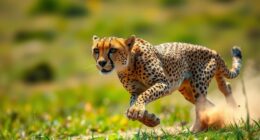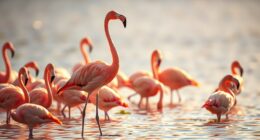Urban wildlife is adapting impressively to city life. Animals like raccoons use advanced problem-solving skills to access food, while coyotes shift to nocturnal habits, feeding on human leftovers. You might notice smaller body sizes among urban species. This helps them maneuver through crowded environments and reduces competition. Foraging strategies also change as wildlife learns to exploit readily available human resources. However, urban living poses challenges, such as habitat loss and human-wildlife conflicts. Understanding these dynamics is essential to fostering coexistence. Continue exploring to uncover more about how these animals thrive in urban settings.
Key Takeaways
- Urban wildlife, such as raccoons and coyotes, display unique behaviors and adaptations to thrive in city environments.
- Smaller body sizes in urban animals enhance mobility and reduce competition for resources in dense habitats.
- Urban wildlife alters foraging behaviors to exploit human food sources, reflecting resilience and adaptability.
- Habitat loss and pollution pose significant challenges to urban wildlife, necessitating effective conservation strategies.
- Collaborative efforts in urban planning and community engagement are essential for supporting diverse wildlife populations.
Understanding Urban Wildlife
Urban wildlife is a fascinating aspect of city life that often goes unnoticed. In urban environments, animals exhibit rapid evolutionary changes, adapting to urban settings in remarkable ways. You might be surprised to learn that many species display unique behaviors compared to their rural counterparts.
For instance, urban raccoons use impressive problem-solving skills, while urban coyotes tend to become nocturnal to avoid human interactions. Additionally, these animals engage in various play behaviors to develop essential skills and foster social interactions, which are vital for their survival in a bustling city environment, as highlighted by the importance of play.
Research has shown that urban wildlife, including birds, bats, bees, amphibians, and reptiles, employs various foraging strategies. Birds and bees act as central place foragers, while reptiles often specialize in specific sites, and bats generally adopt a more flexible approach. This diversity in behavior enhances urban biodiversity, creating a vibrant ecosystem amid human activity.
Effective habitat management plays a significant role in supporting this wildlife. By incorporating features like fallen trees and green spaces, you can enhance biodiversity and cater to the diverse needs of various species.
Understanding urban wildlife helps you appreciate the complex interactions that take place in your city, reminding you that nature thrives even in the most developed environments.
Adaptations to City Life

Urban wildlife has really adapted to city life in fascinating ways. You might notice smaller body sizes in some species, which help them maneuver through crowded environments, while others have changed their foraging behaviors to take advantage of human food sources.
These adaptations not only highlight their resilience but also reveal how they've learned to thrive in habitats dominated by people. For instance, understanding the impact of mental health support on wildlife resilience can lead to better conservation strategies.
Additionally, the way wildlife interacts with urban spaces reflects broader trends in adaptation and survival.
Body Size Adaptations
In bustling cities, wildlife adapts in fascinating ways, often leading to smaller body sizes. Urban animals frequently exhibit this trend, which helps them navigate complex city environments more easily. Smaller body sizes reduce competition for resources, allowing these species to thrive despite the challenges posed by urbanization.
Additionally, the adaptation to urban environments may parallel strategies seen in geothermal energy utilization, where innovative solutions help optimize resource use in a constrained setting.
Studies reveal that various urban wildlife species, from birds to mammals, show a preference for smaller dimensions. For instance, urban birds tend to have smaller beaks than their rural counterparts, enabling them to access diverse food sources in the city. This adaptation is significant as it helps them exploit the unique offerings found in urban settings.
Interestingly, while some urban black bears may weigh about 25% more than those in rural areas, it underscores how food availability can influence body sizes.
The phenomenon of reduced body sizes among urban wildlife highlights the evolutionary pressures that urbanization exerts on species. These adaptations are vital for survival, showcasing the remarkable resilience of wildlife as they adjust to life in city environments.
Foraging Behavior Changes
Wildlife in cities is not just shrinking in size; it's also changing how it forages for food. Urban wildlife adapts to city life by modifying their foraging behavior, taking advantage of human food and diverse food sources that urban areas provide. For example, urban coyotes have integrated approximately 38% human food into their diets, influencing their boldness around people.
To illustrate these adaptations, consider the following table:
| Species | Foraging Strategy | Notable Behavior |
|---|---|---|
| Birds & Bees | Central place foraging | Return to specific bases after foraging |
| Urban Reptiles | Site specialists | Utilize specific locations for food |
| Raccoons | Problem-solving skills | Untie bungee cords from trash cans |
These foraging techniques showcase the remarkable problem-solving skills of urban wildlife. By exploiting diverse food resources, these animals thrive in environments where traditional sustenance might be scarce. As you observe urban areas, pay attention to how these species cleverly adapt their foraging behavior to survive in the bustling cityscape around them.
Habitat Utilization Strategies
Often, city-dwelling animals display remarkable adaptability in utilizing available habitats to thrive.
You'll notice that urban wildlife has developed various strategies to navigate the complexities of the urban landscape. These adaptations not only enhance their survival rates but also allow them to exploit unique habitat features. For instance, similar to how heirloom seeds promote biodiversity, urban wildlife often seeks out diverse environments within cities to secure necessary resources.
Here are some strategies you might observe:
- Smaller body sizes: These help animals maneuver through dense environments.
- Central place foraging: Species like birds and bees return to specific nests or hives after searching for food.
- Site specialization: Reptiles often stick to particular locations that provide necessary resources.
- Dietary flexibility: Many animals broaden their diets to include human food remnants, increasing their survival odds.
- Utilization of green spaces: Parks and gardens act as vital habitats, offering shelter and food sources.
These strategies reveal the resilience of urban wildlife as they adapt to changing environments.
Foraging Strategies in Urban Areas
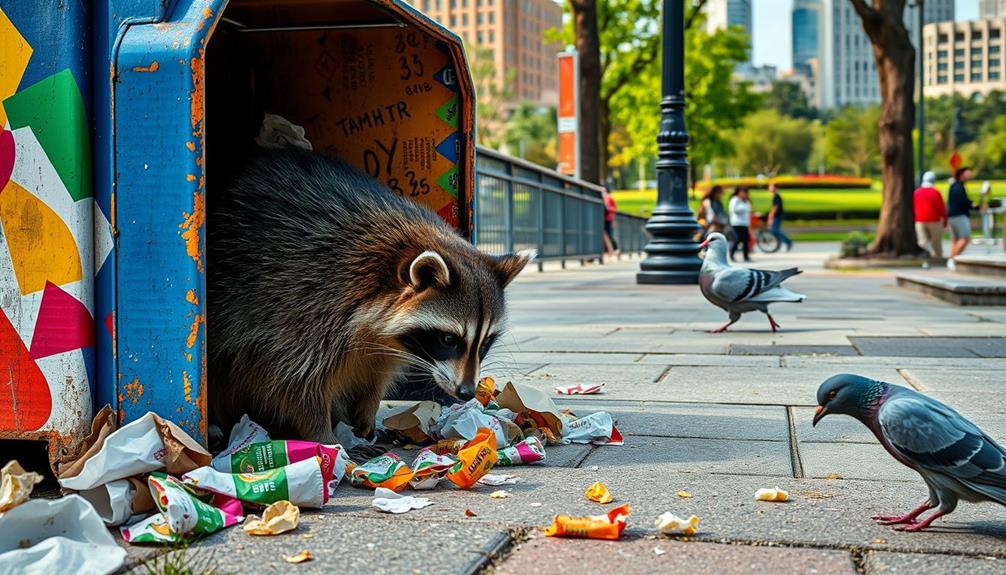
Urban wildlife's foraging strategies reveal fascinating adaptations to city life. As you explore these complex urban environments, you'll notice that different species have developed unique techniques for survival. For example, urban birds and bees often practice central place foraging, returning to a specific base to feed, which aids their navigation. Reptiles, on the other hand, tend to be site specialists, utilizing particular locations with ideal resources.
Here's a quick overview of the diverse approaches urban wildlife employs:
| Foraging Strategy | Description |
|---|---|
| Central Place | Return to a base for feeding |
| Site Specialist | Utilize specific locations for resources |
| Generalist | Exploit various food sources across landscapes |
| Opportunistic | Take advantage of readily available food |
| Seasonal Variation | Adapt foraging practices based on the season |
These foraging strategies greatly influence the adaptability of urban species. By observing how these animals thrive in city living, you gain insight into the resilience and resourcefulness of urban wildlife. Each strategy showcases the remarkable ways in which wildlife adjusts to urban challenges.
Challenges Faced by Urban Species
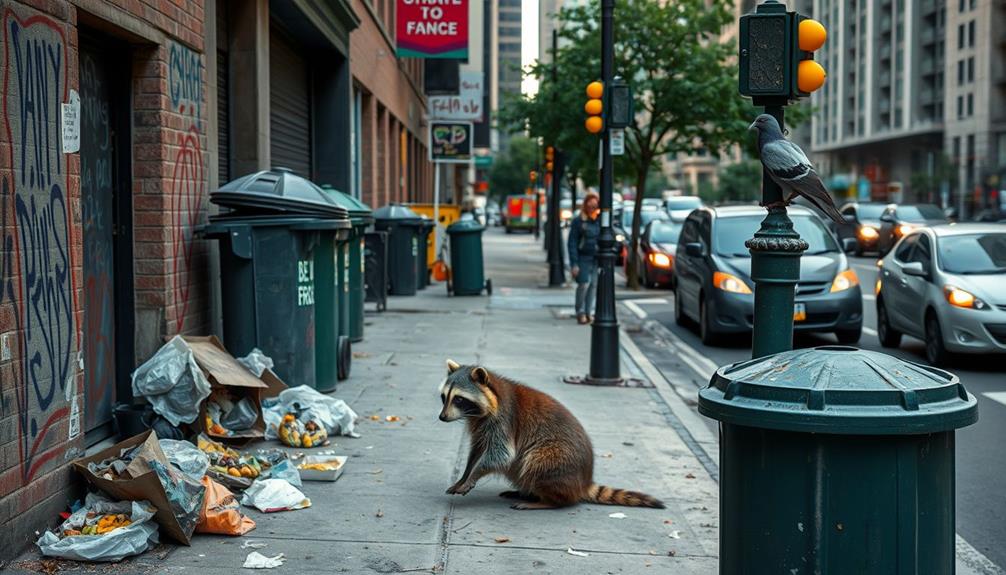
Maneuvering city streets poses significant challenges for many wildlife species. Urbanization leads to habitat loss, forcing these creatures to adapt to a landscape dominated by humans.
Unfortunately, this adaptation often comes at a cost to their survival and reproduction rates. Many species, like urban foxes and raccoons, have learned to exploit human environments, showcasing their remarkable adaptability, similar to how dog breeds have evolved in urban settings, which can also be seen in the diversity of dog breeds and names.
Here are some of the key challenges faced by urban wildlife:
- Habitat loss and fragmentation disrupt natural living conditions.
- Competition for food increases as cities offer human food sources, leading to dependency.
- Dangers from traffic present obstacles like vehicles and artificial lights, affecting natural behaviors.
- Altered diets develop due to reliance on human scraps, compromising nutritional needs.
- Invasive species threaten native species, causing declines in local biodiversity.
As wildlife adjust their behaviors, many mammals are becoming nocturnal to avoid human interactions.
This shift complicates conservation efforts, as understanding their new patterns is essential for effective management. Ultimately, addressing these challenges is critical for ensuring the survival of urban wildlife and maintaining biodiversity in our cities.
Importance of Habitat Management

As urban wildlife continues to adapt to the challenges posed by city life, habitat management becomes crucial for their survival. In expanding urban environments, effective habitat management guarantees that diverse wildlife species can thrive.
By incorporating natural features like fallen trees, you can enhance biodiversity, providing critical resources for various taxa. Utilizing well-draining soil in urban gardens can also support the growth of native plants, further benefiting local wildlife.
To counteract the negative impacts of urbanization, you should consider strategies that support wildlife movement. Designing interconnected green spaces is essential for facilitating access to resources and allowing wildlife to navigate through fragmented habitats.
Research shows that maintaining native plant species and creating green corridors can greatly improve urban biodiversity, enabling species to adapt more effectively.
Furthermore, implementing wildlife-friendly landscaping and preserving natural habitats within cities helps counteract habitat loss. These actions promote the coexistence of human and urban wildlife populations, benefiting both.
By prioritizing habitat management, you contribute to a healthier ecosystem where urban wildlife can flourish amidst the challenges of city life.
Human-Wildlife Interactions
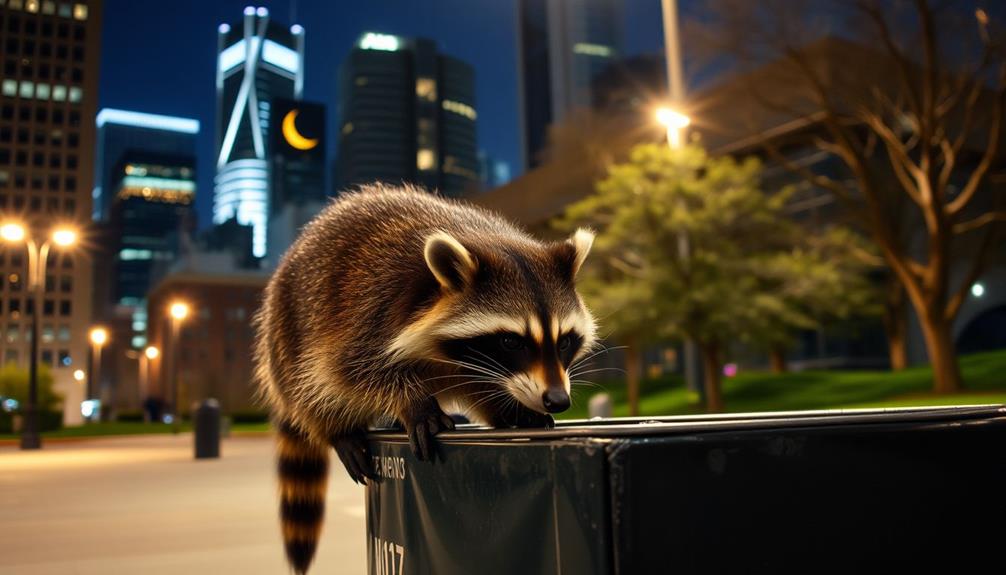
Increasingly, interactions between humans and wildlife are becoming a common occurrence in city environments. Urban wildlife, like raccoons and bears, often displays altered behaviors that can lead to human-wildlife conflicts, especially when they're drawn to food sources.
For instance, in Asheville, North Carolina, residents sharing videos of urban bears have inadvertently increased conflicts by attracting them with birdseed. Research shows that understanding feline behavior and emotional connection can help us relate better to the wildlife around us, as many animals express their emotions and behaviors similarly.
To minimize these encounters, it's crucial to adopt some best practices:
- Secure garbage and compost bins
- Avoid feeding urban wildlife
- Leash pets during walks
- Educate yourself on BearWise practices
- Report aggressive wildlife interactions
Urban coyotes have also adapted by incorporating 38% human food into their diets, making them bolder and more likely to approach people. Feeding urban wildlife can create a dependency that's harmful to both animals and humans, prompting local ordinances against such practices.
Future of Urban Wildlife Conservation

The future of urban wildlife conservation hinges on innovative approaches that address the unique challenges posed by urban environments. Effective conservation strategies must tackle habitat fragmentation and pollution in urban areas, ensuring that wildlife can thrive amidst human development.
Integrating green spaces, such as parks and natural features, into urban planning is essential for supporting diverse wildlife populations and enhancing urban biodiversity. Utilizing architectural solutions can help create innovative spaces that include these green areas as part of urban design.
Community engagement plays a crucial role in these efforts. By involving local residents through educational initiatives and citizen science projects, you can foster public awareness and encourage participation in conservation activities.
Research shows that urban areas can serve as refuges for certain species, emphasizing the need to promote coexistence between wildlife and the community, thereby mitigating conflicts.
Collaboration is key. Government agencies, urban planners, and conservationists must work together to develop sustainable practices that protect urban ecosystems and maintain ecological balance.
Frequently Asked Questions
What Animals Have Adapted to Live in Cities?
You'll find animals like raccoons, coyotes, and urban bears thriving in cities. They've adapted their behaviors, feeding habits, and even physical characteristics, showcasing remarkable resilience and cleverness in maneuvering urban environments despite human presence.
How Are Animals Adapting to Urbanization?
You'll notice raccoons rummaging through trash, showcasing their clever problem-solving skills. Animals adapt to urbanization by altering behaviors, like becoming nocturnal or broadening diets, enabling them to thrive in bustling city environments.
What Wild Animals Are Moving Into Cities?
You'll likely see coyotes, raccoons, and black bears moving into cities. They've adapted their diets and behaviors, thriving on human food and altering their activity patterns to navigate urban environments more effectively.
How Animals Are Adapted to Live in Their Local Environment?
In a world where animals become superheroes, they've adapted brilliantly to their environments. You'll see them evolve, developing unique skills and traits that help them thrive, whether it's finding food or avoiding predators.
Conclusion
As cities grow, wildlife finds ways to thrive in concrete jungles, adapting in remarkable ways. Yet, this survival often comes at a cost, with habitats shrinking and species facing new challenges. You might spot a fox rummaging through a trash can, a symbol of resilience, but it also reflects the struggle for space in a crowded world. By managing habitats and fostering coexistence, you can help guarantee that urban wildlife continues to flourish alongside us, rather than merely surviving.








